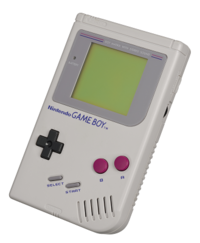| Site Notice |
|---|
|
We have a limited coverage policy. Please check our coverage page to see which articles are allowed. |
Difference between revisions of "Game Boy"
| (One intermediate revision by one other user not shown) | |
(No difference)
| |
Latest revision as of 22:46, 9 October 2023
The Game Boy was Nintendo's first portable console. It was one of the best selling game systems of all time, selling around 118,690,000 units world wide before discontinuing in 1998.[1] Due to its overwhelming popularity, the release of the Game Boy Color was actually pushed back due to the strong sales it still had.
Contents
Versions
Game Boy
The first Game Boy was released in 1989. This original Game Boy was large and gray, with a monochrome dot matrix screen, monaural sound with integrated speaker and stereo sound with headphones. It was playable for an average of 35 hours with four AA batteries. Many peripherals were released for it through its time, the more popular ones being the Game Boy Printer and Game Boy Camera. The Game Boy was also later released with five differently colored bodies.
At the Nintendo World store, there is a Game Boy on display that survived an explosion in the Gulf War. While the screen had to be replaced, the internal circuitry was still operational without any modification.
Hardware Specifications
- CPU: Z80 8-bit CMOS
- CPU Speed: 4.19 Mhz
- RAM: 8 Kbyte
- Maximum Resolution: 160 x 144 pixels
- Colors: Grayscale
- Maximum number of colors: 4
- Maximum sprite size: 8 x 16 pixels
- Maximum number of sprites: 40 sprites
- Minimum/Maximum cart size: 256 Kbit - 16 Mbit
- Sound: 4 Channels
Game Boy Pocket
The Game Boy Pocket was released in 1996 as a replacement for the original Game Boy. The Game Boy Pocket had a smaller frame, a higher contrast and larger screen, though keeping the same resolution display. Despite its screen improvements, the Game Boy Pocket display was still in monochrome and the sound remained the same as it was in the original Game Boy. Another somewhat minor improvement was that the system took two AAA batteries instead of four AA, effectively helping to lighten its weight.
The Game Boy Pocket's link cable port is smaller than the original Game Boy's, requiring either an adapter or a special two-headed link cable to communicate. The Game Boy Pocket's link cable port would be later used on the Game Boy Light and Game Boy Color, and the link cable port on the Game Boy Advance and Game Boy Advanced SP is backward compatible with it when playing a Game Boy or Game Boy Color game.
The first version, a silver reproduction, did not include an LED indicator of battery levels. This feature was added in later models due to popular demand, along with multi-colored units.
Game Boy Light
The Game Boy Light was a system released exclusively in Japan in 1997. It was similar to the Game Boy Pocket, but with the addition of an indigo back-lit screen. The Game Boy Light uses two AA batteries, which provide approximately 20 hours of gameplay with the light off and 12 hours with the light on. It was the only backlit Nintendo handheld console until the release of the Nintendo DS in 2004 (the Game Boy Advance SP utilizes a frontlight in its original model, not a backlight). The Game Boy Light was available in two standard colors: gold and silver.
Game Boy Color
| Main article: Game Boy Color |
Similar to the Game Boy Pocket but with a color screen. It can also support more pixels on the screen. Backward compatible with the Game Boy.
Game Boy Advance
| See also: Game Boy Advance |
A brand new sytem, it is a improved version of the Game Boy Color with a trapezoidal design and better graphics. It is also compatible with the GameCube via the Gameboy player.
Game Boy Advance SP
| See also: Game Boy Advance#Game Boy Advance SP |
It features a clamshell design and boasts the ability to be played in the dark without an external light source using its frontlight. It also has a lithium rechargeable battery as opposed to previous models' AA battery requirement.
Game Boy Micro
| See also: Game Boy Advance#Game Boy Micro |
A second redesign of the Game Boy Advance which has been criticized due to its lack of backwards compatibility with Game Boy Color games; and the fact that it was released after the Nintendo DS, but lacks many of its features.
Gallery
References
- ↑ Annual Report 2006 (PDF File), retrieved 6/1/10
|
|
| |||||||||||||||||||||
| |||||||||||||||||||||
| |||||||||||||||||||||



